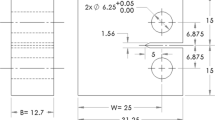Abstract
The macrofracture pattern of a laminated, tempered safety plate glass panel in which failure was initiated by a sharp object was statistically analyzed. The crack density decreased linearly with distance from the fracture origin as did the average distance between successive crack branching events. The average bifurcation half angle, however, remained at about 21°, independent of distance from the fracture origin. This half angle is very similar to that reported for the branching of an individual primary crack in a fracture mechanics specimen. The two branching half-angles are negatively correlated, approaching a maximum of 45° in the extreme.
The curvatures of the new crack paths after bifurcation were also observed to be independent of the distance from the fracture origin and followed the general expression where the coefficient α is a random variable and β is a constant equal to 0.035. It was possible to describe the repetitive crack branching through the concept of a fractal tree with a fractal dimension of 2.58, a value similar to some geological processes. Applying the fractal tree concept, the multiple cascadation phenomenon was reproduced for the range of fractal dusts of z ≤ 4, beyond which degeneration related to excessive selfoverlapping occurred.
{fx49-1}
Similar content being viewed by others
References
F.W.Preston, Journal of American Ceramic Society 18 (1935) 175–176.
A.Smekal, Journal of the Society of Glass Technology 20 (1936) 432–453.
D.G.Christie, Journal of the Society of Glass Technology 36 (1952) 74–89.
H. Kolsky, in Fracture, B.L. Averbach, D.K. Felbeck, G.T. Hahn and D.A. Thomson (eds.), MIT Press & John Wiley (1959) 281–296.
C.J.Phillips, in Fracture 7, H.Liebowitz (ed.), Academic Press, New York (1972) 2–37.
L.Orr, Material Research and Standards 12 (1972) 21–27.
B.A.Bilby, Journal of Materials Science 15 (1980) 535–556.
S.W.Freiman, in Glass and Technology, Vol. 5, D.R.Uhlmann and N.L.Kreidl (eds.), Academic Press, London (1980) 21–78.
R.J.Charles, Journal of Applied Physics 29 (1958) 1549.
M.Ashizuka, T.E.Easler and R.C.Bradt, Journal of American Ceramic Society 66 (1983) 542–550.
P.Acloque and C.Guillemet, in Advances in Glass Technology, Part 2, F.R.Matson and G.E.Rindone (eds.), Plenum Press, New York (1963) 95–106.
R.C. Bradt, in Advances in Ceramics, Vol. 22, V.D. Frechette and J.R. Varner (eds.), The American Ceramic Society (1988) 417–426.
R.Gardon, in Glass Science and Technology, Vol. 5, D.R.Uhlmann and N.L.Kreidl (eds.), Academic Press, London (1980) 145–216.
A.Fayet, C.Guillemet and P.Acloque, in Proceedings, 8th International Congress on High Speed Photography, N.R.Nilsson and L.Högberg (eds.) John Wiley & Sons, Stockholm (1969) 433–439.
J.E.Field, Contemporary Physics 12 (1971) 1–31.
A.B.J.Clark and G.R.Irwin, Experimental Mechanics 6 (1966) 321–330.
J.W.Dally, Experimental Mechanics 19 (1979) 349–367.
K.Ravi-Chandar and W.G.Knauss, International Journal of Fracture 26 (1984) 141–154.
J.Congleton, in Dynamic Crack Propagation, G.C.Sih (eds.) Noordhoff International Publishing, Leyden (1973) 427–438.
A.S.Kobayashi, B.G.Wade, W.G.Bradley and S.T.Chiu, Engineering Fracture Mechanics 5 (1974) 81–92.
E.H.Yoffe, Philosophical Magazine 42 (1951) 739–750.
G.C.Sih, in Elastodynamic Crack Problems, G.C.Sih (ed.) Noordhoff Publishing, Leyden (1977) 17–46.
M. Ramulu, A.S. Kobayashi and B.S.-J. Kang, ASTM STP 833 (1984) 130–148.
M.Ramulu and A.S.Kobayashi, Theoretical and Applied Fracture Mechanics 5 (1986) 117–123.
P.S.Theocaris and H.G.Georgiadis, International Journal of Fracture 29 (1985) 181–190.
M.Ramulu, A.S.Kobayashi, B.S.-J.Kang and D.B.Barker, Experimental Mechanics 23 (1983) 431–437.
M.Ramulu, A.S.Kobayashi and B.S.-J.Kang, Journal of Pressure Vessel Technology 104 (1982) 317–322.
M.Ramulu and A.S.Kobayashi, International Journal of Fracture 27 (1985) 187–201.
R.W. Rice, in Advances in Ceramics, Vol. 22, The American Ceramic Society (1988) 3–56.
M. Ramulu, R.C. Bradt, A.S. Kobayashi and K.H. Yang, in Advances in Ceramics, Vol. 22, The American Ceramic Society (1988) 215–227.
L.R.F.Rose, International Journal of Fracture 12 (1976) 793–813.
M.L. Williams and W.G. Knauss (eds.) International Journal of Fracture 27 (1985) 23–312.
J.J. Mecholsky, T.J. Mackin and D.E. Passoja, in Advances in Ceramics, Vol. 22, The American Ceramic Society (1988) 127–134.
K.Ravi-Chandar and W.G.Knauss, International Journal of Fracture 26 (1984) 189–200.
Westerman, Journal of Mathematical Physics 43 (1965) 191–199.
A.M.Freudenthal, in Fracture 2, H.Liebowitz (ed.) Academic Press, New York (1968) 591–619.
R.E.Bullock and J.L.Kaae, Journal of Materials Science 14 (1979) 920–930.
T. Sakai and T. Tanaka, in Fatigue '84, Vol. 2, J. Baeklund, A.F. Blom, and C.J. Beevers (eds.), EMA Publishers (1984) 1125–1137.
T.Tanaka, T.Sakai and K.Okada, Bulletin of the JSME 28 (1985) 209–216.
A.M.Mood, F.A.Graybill and C.Boes, Introduction to the Theory of Statistics, McGraw-Hill Book Co., New York (1974) 162.
E.P.Bullen, F.Henderson and H.Wain, Philosophical Magazine 21 (1970) 689–699.
J.Congleton and N.J.Petch, Philosophical Magazine 16 (1967) 749–760.
H.Kirchner, R.M.Gruver, M.V.Swain and R.C.Garvie, Journal of American Ceramic Society 64 (1981) 529–533.
J.F.Kalthoff, International Journal of Fracture 7 (1971) 478–480.
A.Papoulis, Probability, Random Variables, and Stochastic Processes, McGraw-Hill Book Co., New York (1984) 135.
J.S.Hawong, A.S.Kobayashi, M.S.Dadkhah, B.S.-J.Kang and M.Ramulu, Experimental Mechanics 27 (1987) 146–153.
B.B.Mandelbrot, The Fractal Geometry of Nature, W.H. Freeman and Co., New York (1977).
R.Orbach, Science 231 (1986) 814–819.
E.E.Underwood and K.Banerji, Materials Science and Engineering 80 (1986) 1–14.
D.W. Schaefer, MRS Bulletin (1988) 22–27.
B.B.Mandelbrot, D.E.Passoja and A.J.Paullay, Nature 308 (1984) 721–722.
J.J.Mecholsky, D.E.Passoja and K.S.Feinberg-Ringe, Journal of American Ceramic Society 72 (1989) 60–65.
P.Pfeifer and D.Avnir, Journal of Chemical Physics 79 (1983) 3558–3565.
D.Avnir and D.Farin, Journal of Chemical Physics 79 (1983) 3566–3571.
D.M.Mark and P.B.Aronson, Mathematical Geology 16 (1984) 671–683.
Author information
Authors and Affiliations
Rights and permissions
About this article
Cite this article
Sakai, T., Ramulu, M., Ghosh, A. et al. Cascadating fracture in a laminated tempered safety glass panel. Int J Fract 48, 49–69 (1991). https://doi.org/10.1007/BF00012502
Received:
Accepted:
Issue Date:
DOI: https://doi.org/10.1007/BF00012502




